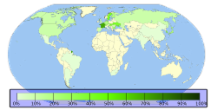Nuclear Power and CO2
The Benefits of Nuclear Power in Climate Combat are questionable
In the energy and climate debate, some opinions that are taken for granted do not endure critical review. There is a common belief that increasing nuclear power would automatically reduce our ecological footprint and be a solution to the problem of global warming. This argument is repeated in particular by politicians in countries where nuclear doctrine is highly worshipped such as France and Finland. However, examining the hard statistics shows that the argument is at least questionable, even false.
The first correction to our beliefs is the easily seen fact that nuclear power is by no means emission-free. Benjamin Sovacool, professor at the State University of Singapore, who has compared greenhouse gas emissions for the entire lifetime of different types of power plants, has shown that even though nuclear power (66 g / kWh) overcomes emissions of coal (960 g / kWh), oil (778 g / kWh) and gas (443 g / kWh), it is by no means "carbon free" and is clearly beaten by solar energy (13-32 g / kWh), biogas (11 g / kWh), wind power (10 g / kWh) and hydropower (10 g / kWh).
Concrete information on whether nuclear power really helps in reducing global warming or not, is achieved by comparing nuclear dependence (percentage of all electricity in the country, for example, 32% in Finland) to ecological footprint. The ecological footprint is measured in global hectares, which is the area of land needed to absorb the emissions produced by the country. For example, Finland's footprint is over 30 million global hectares and one Finnish footprint is 6.2 global hectares.
Statistical data shows that when comparing countries with approximately same size and equally high standard of living, their ecological footprint does not depend on whether they use a lot of nuclear power or little or not at all. For example, France's dependence on nuclear power (77%) is fourfold compared to Germany (18%) and the countries' ecological footprints are roughly equal. Swiss and Austrian footprints are at the same level, although their dependence on nuclear power is 40% and 0% respectively. Belgium's dependence on nuclear power (54%) is more than ten times higher than in the Netherlands (4%), with the same footprint.
If increasing nuclear dependence would lighten ecological footprint, it should correspond mathematically. However, this doesn't happen. By investigating a larger number of nuclear countries, we can actually find a linear correspondence, but, contrary to common belief, a reversed correspondence: increased nuclear power dependence actually increases ecological footprint.
Another important result comes from a simple comparison of ecological footprints of "nuclear world" and the "non-nuclear world". In reality the border between these two worlds lies inside countries, between densely populated areas and scarcely populated areas. Of course there are several non-nuclear urban regions as well as nuclearized rural regions, but roughly the divisive line exists between urban and rural populations. Anyway, for simplicity, we compare countries which use nuclear power and countries which don't. The total population of all nuclear power countries is about 4.3 billion people, and the total population of all countries that do not have nuclear power is about 3.5 billion.
Calculating and combining the numbers from the country-level statistical data (see the list of source materials) we obtain the following. The total ecological footprint of all nuclear countries is about 12 billion global hectares, and the total ecological footprint of all non-nuclear countries about 7 billion global hectares. The per capita result is 2.8 and 2.0 global hectares. Thus, those who live in nuclear power countries warm more of the Earth's climate than those living in non-nuclear countries.
Author PhD Tapani Jussila (University of Helsinki, Tokyo University of Tokyo Daigaku) is a mathematician who lectures and writes about energy issues.
This article is based on the following statistical data and documents:
- IAEA PRIS (International Nuclear Energy Dependency Databases of the International Atomic Energy Organization)
- Living Planet (WWF, European Space Agency, Zoological Society of London and Global Footprint Network)
- Ecological Footprint of the International Journal of Ecodynamics compilation article (Galli, Kitzes, Wermer, Wackernagel, Niccolucci, Tiezzi).
The images are based on the same sources.

Image 2. Ecological footprint (Living Planet 2012). Darker colour means heavier footprint

Image 1. Dependency on nuclear power (IAEA). Darker colour means more dependency
